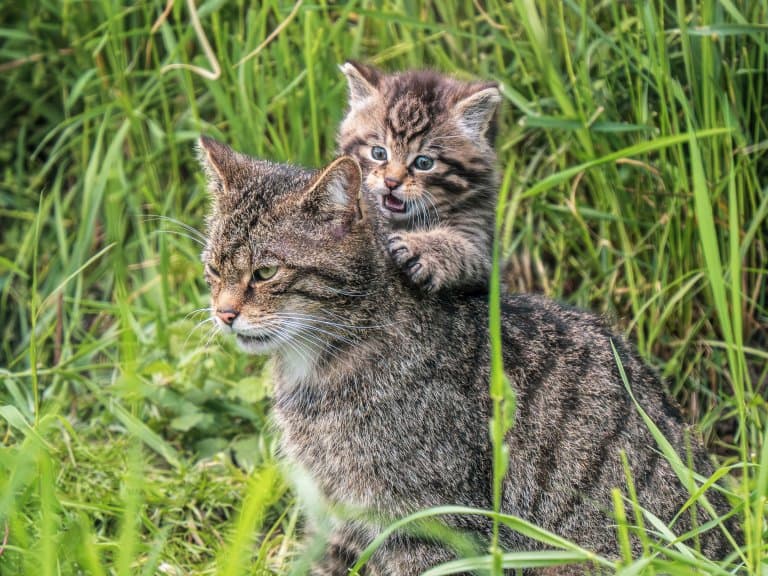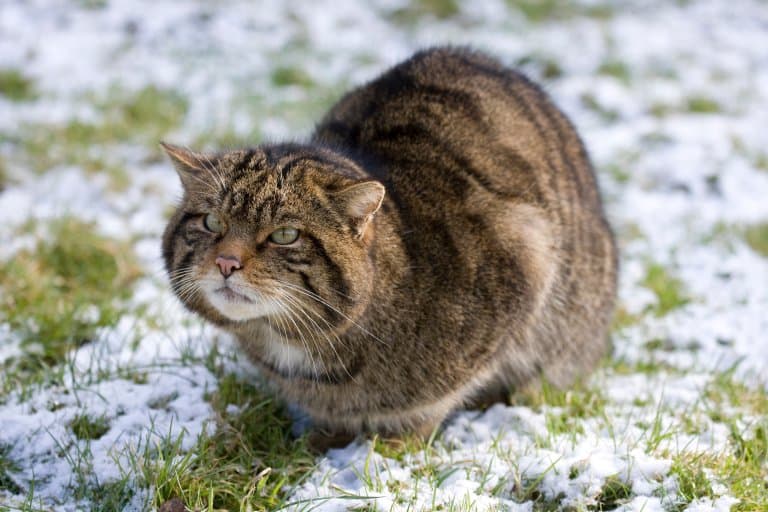Scottish Wildcat Profile
The European wildcat is native to the continent and skulks about secretly in forests, camouflaged and quiet, hunting animals as big as a hare. It’s a small predator, but a powerful one, and one that has spawned legends with its bizarre noises and wild nature.
In Britain, there were once wild cats all over, but as humans expanded, the cats were driven out; persecuted as pests and with their habitats destroyed, their only refuge became the Scottish Highlands. Now, even this remote stronghold is under threat.
The Scottish wildcat is a small population of European wildcats that live in the remote woodlands of Northern and Eastern Scotland.

Scottish Wildcat Facts Overview
| Habitat: | Temperate forest, mixed woodlands |
| Location: | Northern and Eastern Scotland |
| Lifespan: | 15 years in captivity |
| Size: | Up to 65 cm (26 in) |
| Weight: | Up to 7.5 kg (16 lb) |
| Colour: | Striped, with a solid tabby patterning |
| Diet: | Mostly rabbits, mice, birds and voles |
| Predators: | Humans |
| Top Speed: | Cattish speed |
| No. of Species: | 1, subspecies F. s. silvestris |
| Conservation Status: | Critically Endangered (UK Red Lists) |
Scottish wildcats inhabit a few small remote wooded highlands of Scotland. They are particularly active at night, and will prey on rabbits, voles and birds.
The introduction of a very similar animal has all-but spelled the end for this critically endangered wild cat.
Domestic cats bring with them diseases, but they also breed with the wild cat, diluting the gene pool and making conservation very complicated.
As such they may already be too far gone to save with in-situ conservation alone; breeding programs and genetic research could be the last hope for this ancient little cat.
Interesting Scottish Wild Cat Facts
1. They’re not feral
Despite their familiar appearance, wild cats are not the same as domestic cats that have escaped and run wild. Firstly, they’re a totally different species, but also, animals that were once captive and/or domesticated but have set up communities in the wild are called feral.
Sadly, feral cats are invasive all over the world, and with serious repercussions. As powerful little hunters, they kill tens of billions of animals every year and contribute substantially to the decline of local wildlife.
Wild cats, the true native cats to Britain, are suffering that decline, affected in more ways than one by the domestic cat, who has wreaked havoc on their number. 1

2. Scottish wildcats are heavier than domestic cats
While they do look similar to your household moggie, the wild cat is far denser and has longer legs.
They also have a thicker, stronger skull, and this supports a powerful bite. In general, it’s also a bit bigger than a house cat, and all-in-all is a much stronger animal.
But this has not been enough to guarantee its spot in the country, and the animal might no longer be found in its pure form in the wild at all.
3. They might be functionally extinct in the wild
As you might have guessed from looking at it, the wild cat is closely related to the domestic cat, despite being a different species. This relationship has led to the two animals reproducing, and successfully so; to the point where there might not be a clean bloodline for the wild cat left.
Hybridisation with the feral cat may have permanently changed the genetic makeup of the wild populations, and if it hasn’t entirely, it’s certainly at risk of doing so very soon.
Some suggest that the Scottish wild cat is now functionally extinct in the wild as a result. 2

4. They were once widespread
Apart from the sanitation, the medicine, education, wine, public order, irrigation, roads, the freshwater system, and public health … The Romans also brought a bunch of bloody cats with them all over the empire, including to Britain, where they immediately went to work displacing everything else.
It wasn’t domestic cats that pushed the wild cat out of England. Rather it was the expansion of agriculture and the condemnation of the predator as a pest that started it. Cats would play a significant role in sealing the deal later, though.
But before this, the Scottish wild cat would have been prevalent throughout mainland Britain, and being wild animals, they were a lot less familiar and more frightening to the natives.
Because of this, numerous legends descend from wild cats, including the idea that a cat could steal a person’s soul.
5. King of Cats
Cat-sith is a common legend surrounding cats, originating from somewhere in Celtic territory. This one comes from a thousand years after the Romans buggered off but from far enough North that its inspiration was probably the Scottish wild cat.
Cat-sith was a devious character, all black aside from a white spot on his chest, and he’d go around climbing over coffins and corpses of the recently-deceased before burial, and before the soul had figured out which way it was going.
It was thought that Cat-sith would then steal the soal, so guards were posted in the Scottish Highlands during the vulnerable moments between death and burial to prevent this from happening.
As a cat, Cat-sith was attracted to warmth, so no fires were allowed to be lit in the presence of the body.
Given the bizarre wails and oh long Johnsons cats are capable of, it’s no wonder the locals thought they were weird.
There was another British folk tale about a man’s cat, who, upon overhearing that someone had died, cried out, “Then I’m the King o’ the Cats!”, rushed up the chimney and was never seen again.

6. They were considered vermin
Despite their influence on human culture, wild cats were considered a pest, and this played a huge role in their eradication from the islands.
Game breeders and hunters would kill the cats as competition for their birds, and their persecution essentially wiped them out from all but the remotest Scottish Highlands.
From here, they made a good attempt at recovery, but again the hybridisation and diseases that the domestic cat brought with its encroachment have proven insurmountable for the species.
7. Scottish wildcats are subject to cat conservation
Since the ‘80s, the Scottish wildcat was protected in Scotland and has been listed as a priority species since 2007. It’s considered Critically endangered and possibly functionally extinct in the wild now, but captive breeding might hold the key to its survival.
Conservationists exchange wild cats to keep the gene pool healthy, and the eradication of feral cats and the neutering of loved ones is part of the process of protecting what’s left in the wild.
Wild cat sanctuaries have been set up, but in 2018 the population was assessed as no longer viable. 3
8. There is hope for Scottish wildcats
From reintroductions, it is possible that a return to some semblance of its former glory could be on the cards for this rare animal.
Conservation has moved forward in leaps and bounds in Europe in recent decades and the science and significance of reintroductions is finally starting to sink in.
Sadly, there is still a lack of funding and therefore data, for a better understanding of the wild cat situation in Scotland at the moment, and survey methods appear to lack consistency, so it remains to be seen whether the species can be rescued from the brink.
But recent genetic research is still pushing to better understand the impacts of hybridisation in wild populations and support conservation efforts to mitigate the consequences of the recent deterioration of the lineage. 4 5
Scottish Wildcat Fact-File Summary
Scientific Classification
| Kingdom: | Animalia |
| Phylum: | Chordata |
| Class: | Mammalia |
| Order: | Carnivora |
| Family: | Felidae |
| Subfamily: | Felinae |
| Genus: | Felis |
| Species: | Felis Silvestris |
| Subspecies: | Felis Silvestris Silvestris |
| Population: | Scottish Wildcat |
Fact Sources & References
- BBC (2021), “Scottish ‘Highland Tiger’ wildcat more endangered than Asian cousin”, YouTube.
- Kerry Kilshaw (2015), “Mapping the spatial configuration of hybridization risk for an endangered population of the European wildcat (Felis silvestris silvestris) in Scotland”, Research Gate.
- David Grimm (2023), “The Scottish wildcat has been wiped out by breeding with domestic cats”, Science.
- BBC (2021), “Scottish ‘Highland Tiger’ wildcat more endangered than Asian cousin”, YouTube.
- “European Wildcat”, IUCN Red List.
